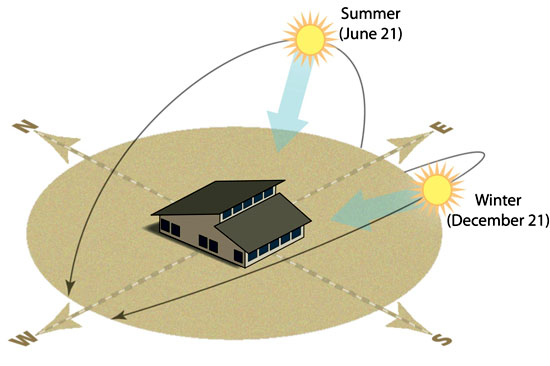Managing Daylight with Automated Solar Control
Solar Variability
In order to more fully understand the benefits of automated shading systems, it is necessary to appreciate the basics of solar variability. The position of the sun varies from day to day, season to season, and by geographic location. The accompanying illustration shows the sun’s elevation from winter to summer months. The lower the sun’s elevation, the lower the solar protection needs to be to block glare and heat gain. It follows that, conversely, the higher the elevation of the sun, less solar protection is required, allowing for daylighting.
In the winter months, there is more of a glare issue, because the sun is not out long but it is low in the sky. In the summer months, there is more of a solar gain issue, because the sun is out a long time. The HVAC system must work longer to hold a consistent temperature if solar gain is not taken into account. The point to stress here is that daylight levels can vary widely both in terms of foot candles and quality of light, based on climatic conditions. For example, daylight that enters a building can be diffused by clouds, reflected off water or pour in from a bright sun with, of course, changes in angle and position as the earth makes it way around its orbit of the sun.

Image courtesy of Draper, Inc.
Automated shades account for all these factors and can automatically adjust the shades for occupant comfort. If constant shade movement is a concern, the scheduled automated shade movements can be programmed to adjust as frequently or infrequently as the owner or designer calls for. Shades can move in various percentage increments, i.e. 5 percent or 20 percent. Changing the percentage ultimately changes how many sun tracking movements will occur throughout each day.
Many commercial building spaces are including daylighting strategies, not only to be more efficient, but to also provide the proper amount of task lighting for optimal working conditions. Solar shades can work nicely in conjunction with artificial lighting control to optimize energy performance, or be a stand-alone system and create daylighting autonomy.
Options for Motorizing a Shade
Before considering the range of automated shading solutions, a brief look at how a shade is motorized is in order. The following are constituent parts of a motorized shade: the tube, motor, fabric, brackets, and fascia. The motor can be inserted into the tube and secured by either riveting the drive wheel to the tube or by the tube’s profile design. The fabric is affixed to the tube either by adhesive or spline attachment. In the first scenario, the adhesive would roll round and would not indent the fabric as a spline attachment can. The adhesive is merely for initially attaching the fabric to the tube and lining it up. The fabric wrap is what actually holds the fabric on the tube. The spline attachment scenario allows one to more easily change or replace fabric panels on installed shades. It is helpful to note that substantially larger and heavier products such as projection screens and wall dividers use adhesives, so each method has been tested and proven in service for years.
Generally speaking, brackets are mounted and the tube attaches to brackets. However, there are also other ways of mounting a shade, such as a head box/pocket scenario. Architects should also be aware of the cost advantages of coupled shades. Coupled shades are usually suggested by the window shade supplier after reviewing project specifications and submitting a bid package to the general contractor. This scenario can have several advantages, the most obvious of which is cost. Coupled shades reduce the number of motors required. Fewer motors mean less wiring, fewer circuits, conduits, and other accessories. In terms of tracking, coupled shades will always start and stop at the same time and ensure hem bar alignment.









